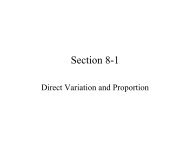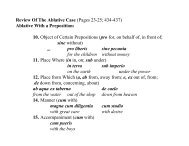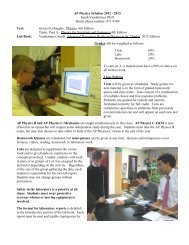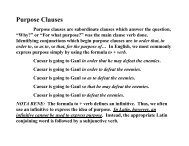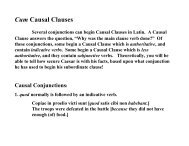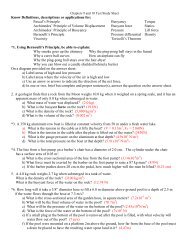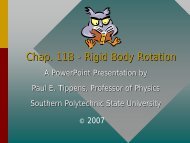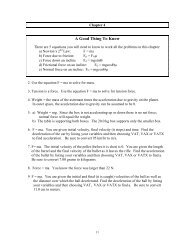Homework Hints Chapter 01-03.pdf
Homework Hints Chapter 01-03.pdf
Homework Hints Chapter 01-03.pdf
Create successful ePaper yourself
Turn your PDF publications into a flip-book with our unique Google optimized e-Paper software.
<strong>Chapter</strong> 11. To express the answer in seconds, convert years to days (use 364 days in one year), days tohours and hours to seconds. Use the factor/label method.2. Rules for significant digits are covered on page 7 of the text and pages 1-3 in the lab book.3 . Read “Powers of 10” on page 4 of the lab book.4. Read “Powers of 10” on page 4 of the lab book.6. See page 5 “assumed uncertainty.”uncertaity7. % Uncertainty = x100measurement8. For addition and subtraction, round the answer to the least precise digit.Example: 1.003 + 2.1 + 12.43 = 15.59. For multiplication and division, round the answer to the least # of significant digits.Example: 4.63 x 12 = 5612. The prefixes of Table 1-4 are on page 9 of the text.14. Use a meter stick and a kg scale, or find these values using a yard stick and a bathroomscale, and convert.16. a) Set up a conversion for feet to yards and then square both factors.b) Set up a conversion for meters to feet and then square both factors.17. distance = rate x time. Find time.18. a) convert meters to inches. b) Convert meters to centimeters.20. a) Just convert miles to kilometers. The time in the denominator stays the same.b) Convert meters to feet. The time in the denominator stays the same.c) Set up “goal posts” with kilometers on top and hours on the bottom. Then convertkilometers to meters and hours to seconds.22. a) Distance = speed x time. Multiply the speed of light in meters/second times the # ofseconds in one year. To convert years to seconds, use 365 days per year, 24 hours inone day and 3600 seconds in one hour. Your answer will be in meters.b) Convert 1.5x10 8 km to meters. Use that as your conversion factor for meters to AU.Then convert your answer from part (a) to AU.c) Speed = Distance / time. Divide your distance in AU from part (b) by the numberof hours in one year.1
35.1 slicecylindricalsilicon crystal47. Use a meter stick to measure the length of your forearm in meters. Use that as yourconversion factor and convert the dimensions from cubits (1 forearm) to meters.49. Opposite angles are equal. Use sine or cosine and the known length of the base of theright triangle formed to find the length of the other side.50. % uncertainty = uncertainty divided by the measured value. Change years to secondsand compare.2
<strong>Chapter</strong> 2A Good Thing To KnowThere are 4 equations you will need to know to work all the problems in this chapter:a) The distance equation: x = vtb) The VAT equation: v v + at= 02 2c) The VAX equation: v = v + 2aΔx0d) The VATX equation:1 Δ x = v0 t + at223. Convert km/h to m/s. Then use the distance equation.4. Just convert the distances. The times stay constant.7. Use the distance equation: x = vt to find the time to travel the 130 km. Subtract that fromthe total time to find the time to travel the final distance.a) Use the distance equation to find the distance traveled after you slowed down, and addthat to the initial 130 km.b) Divide the total distance by the total time.9. and 10. Average speed = total distance per time. Average velocity is the displacement(shortest route from start to finish) per time.11. Time = distance / speed. If the trains are going in opposite directions, either toward oraway from each other, relative velocities add.12. Change km/h to m/s in both cases. Use relative velocities (see class notes).14. For average speed, use the distance equation in both cases to find the time to travel to andfrom the destination. Add those times to the time for the lunch break. Then divide thetotal distance by the total time. For velocity, just take the average of the two velocities.15. The 2.5 s = the time for the ball to travel the length of the lane + the time for thesound to travel back. Time = distance / velocity. Find the time for the sound to travelback to the bowler using 340 m/s for the speed of sound, and the length of the lane as thedistance. Then subtract that from the 2.5 seconds to find the time for the ball to traveldown the lane. Speed = distance per time. Find the speed of the ball using the length ofthe lane and the time left after the time for sound to travel the length of the lane issubtracted.3
16. You’re given initial velocity, final velocity and time. Choose from VAT, VAX orVATX and solve for acceleration. Be sure to convert km/hr to m/s first.17. You’re given initial velocity, final velocity and time. Choose from VAT, VAX orVATX and solve for acceleration. When you convert m/s 2 to km/hr 2 for part b, don’tforget to square the times.18. Convert km/hr to m/s, and list your variables: v o , v, Δx and a. Choose VAT, VAXor VATX and solve for a.19. Convert km/hr to m/s, and list your variables: v o , v, Δx and a. Choose VAT, VAXor VATX and solve for a. To get your answer in g’s, divide a by 9.8.20. Graph the distance vs. time data. The slope of the line is the velocity. If the slope ischanging (a curve) then the velocity is changing, and the object is accelerating.x − x0Find the velocity at each time using the equation: v = . Then graph each velocityt − t0vs. time. The slope of that graph is the acceleration.21. List your variables; v, t and v o , and solve for a. Choose VAT, VAX or VATX foryour equation23. List your variables; v, Δx and v o , and solve for a. Choose VAT, VAX or VATX foryour equation. The plane started at ‘takeoff” so you can assume v o = 0.26. List variables: a, v, Δx and solve for v o . Choose VAT, VAX or VATX for yourequation. The car skidded to a stop, so you can assume the final velocity is 0.28. First, convert km/hr to m/s. Choose VAT, VAX or VATX for your equation.a) list your variables: v o , v, and a and solve for Δx. Add to that the distance the carwill travel at the initial speed for that one second it takes to react.b) same as part (a) using the different value for acceleration.33. Since the stone is dropped, the initial vertical velocity is 0. You can use the “distance tofall” equation (see lecture notes).34. Since the car rolls gently, the initial vertical velocity is 0. Acceleration is due to gravity,they want time and you’re given final velocity. Convert the given velocity to m/s and listyour variables. Choose VAT, VAX or VATX for your equation and solve for time.4
35. If King Kong falls, the initial vertical velocity is 0.a) You’re given distance, acceleration is due to gravity and they want time. Use the“time to fall equation.”b) Now you know acceleration, v o , time and distance. Choose VAT, VAX or VATXfor your equation and solve for the final velocity.36. We can assume the ball stops at the top of its trajectory. List your variables, v o, v, and g.Choose VAT, VAX or VATX for your equation.a) Solve for Δxb) Solve for the time it took to reach that altitude, then double it to include the timeto fall back down.37. If it took 3.0s to go up and come down, it must have takes ½ that time to just go up.The ball stops at the top of its trajectory, making the final velocity = 0. You have thetime it took to reach the top, the final velocity and acceleration. Choose VAT, VAX orVATX for your equation and solve for initial velocity and then distance.38. Use the distance to fall equation, and calculate the position of the object at each½-second time interval from 0 – 5 seconds. Now you have v, v o , a, t and Δy for eachtime interval. Calculate final velocity for each and make a velocity vs. time graph.39. The package has an initial vertical velocity up (+) and it decelerates due to gravity (-9.8).It was released at an initial distance (-) but continues up some distance because of itsinitial velocity, before it stops and falls. This problem can be solved in one step usingVATX and the quadratic equation, but you must be careful with your (+) and (-) signs.OR, it can be solved in three steps as follows:a) You’re given initial velocity, acceleration is due to gravity and you know it willstop at the top of its trajectory. Choose VAT, VAX or VATX for your equationand solve for the distance that the package went up before it stopped. Add that tothe initial vertical height.b) Use the time to fall equation and calculate the time it took the package to fall thetotal distance calculated in step a).c) Choose VAT, VAX or VATX for your equation and solve for the time it took forthe package to travel to its final height before it stopped. Add the two timestogether for the total time the package was in the air.Find the distance up and add that to the 105m.time up105mtime to fallCalculate the time to fall the total distanceand add that to the time it took to go up.5
42. a) You know initial velocity, distance and acceleration. Choose VAT, VAX or VATXfor your equation and solve for final velocity at the given altitude.b) Now you have initial velocity, distance, acceleration and final velocity. Use VATXand the quadratic equation to solve for time.44. You’re given time, distance and you know acceleration is due to gravity. Choose VAT,VAX or VATX for your equation:aa). Solve for the initial velocity of the rock at the top of the window.bb). Let the initial velocity you found in part (a) be the final velocity2.2m of the rock after it fell from the inital drop point on top of the roofto the top of the window. Since it was dropped, the inital velocityc at position (a) was v o= 0. Now you know intitial velocity, finalvelocity and acceleration. Choose from VAT, VAX or VATXand solve for the distance the rock fell form position (a) to (b).(building)45. This is a lot like the bowling ball problem (#15). You can use the “distance to fallequation,” but the time will be equal to the 3.2 s – the time for the sound to return ( 340y Δ ).This will put you in the quadratic equation, solving for Δy. Have fun!47. Part (a) is just like the helicopter problem in #39. For part (b), list your variables. Youhave initial velocity, distance acceleration and time. . Choose VAT, VAX or VATXfor your equation and solve for v o . One way to do part (c) is to use the initial velocitygiven, assume it stops at the peak of the trajectory an solve for the initial Δy. Then addthat to the height of the cliff.48. a) You know the final speed at 28 m and the acceleration. Choose VAT, VAX orVATX for your equation and solve for v o .b) Now you know v o , acceleration and v (it stops at the top). Choose VAT,VAX or VATX for your equation and solve for Δy.c) Find the time to fall that distance Δy and double it to account for the time up.6
50. The instantaneous velocity is equal to the slope of the line tangent to the curve at thatpoint. Estimate the slope of the line tangent to each of the times given in this problem.DO NOT MAKE MARKS IN THE TEXT BOOK.52. Use the graph shown in Fig. 2-28 on page 39. The slope of a distance vs time graph isequal to the velocity. Where the slope is steep, the velocity is high. Where the slope isnot very steep, the velocity is lower. Where the curve is horizontal, the slope is 0 andthe velocity is 0. Distance is on the y-axis. A (+) slope indicates one direction and a(-) slope indicates motion in the opposite direction.55. Use the slope of the graph at each 10 second interval to determine the velocity at thatpoint. Graph the velocity values vs. time.57. a) You know the initial vertical velocity is 0, and that acceleration is due to gravity.Choose VAT, VAX or VATX for your equation and solve for the final velocity ofthe jumper after falling 15 meters.b) Let this be the initial velocity for his deceleration over the 1.0 meter that the netstretches. Now you now have initial velocity as he hits the net, final velocity after itstops him, and distance over which he stopped. Choose from VAT, VAX or VATXand solve for acceleration.b) Think about it!59. Convert 30 g’s to acceleration in m/s 2 to determine acceleration. Then convert 100 km/hrto m/s. List your variables v o , v and a. The distance the car collapses is the distance overwhich the car decelerated. Choose VAT, VAX or VATX for your equations and solvefor Δx.77. a) Convert km/hr to m/s. Us a coordinate system such that the point where the speederpasses the policeman is at the origin.b) You are given velocity, distance and acceleration (a = 0, he is traveling at constantvelocity) of the speeder. Choose from VAT, VAX or VATX and solve for time.c) You are given initial velocity (he was sitting still), acceleration and time (from part b)for the police officer. Choose from VAT, VAX or VATX and solve for acceleration.d) You have initial velocity, acceleration and time for the police officer. Choosefrom VAT, VAX or VATX and solve for final velocity.78. a) The first stone is dropped, so it has no initial vertical velocity. Use VATX and solvefor vertical distance in terms of Δy and t 1 . The second stone has an initial verticalvelocity, but travels the same vertical distance as the first. Use VATX for thesecond stone, and solve for vertical distance in terms of Δy and using (t 1 – 2.00) for t 2 .Now set the two equations equal to each other and solve for t 1 .b) You now have initial vertical velocity and time for the first stone. Solve for verticaldistance.c) You have initial vertical velocity, distance and time for both stones. Choose fromVAT, VAX or VATX for your equations and solve for final velocity.7
<strong>Chapter</strong> 32. Draw the problem out and find length of the diagonal.1<strong>01</strong>8164. The vectors are at right angles to one another. Use Pythagorean theorem to solve.5. Get a metric ruler and a protractor and draw the 3 vectors as described. Now measurethe distance between the beginning of the first vector and the end of the third. That is themagnitude of the length or size of the resultant vector. Now measure the angle of thatvector relative to the horizontal for the orientation of the vector.8. A negative x axis means it points left. A +45 o angle means it points up and to the right.The tips of the arrows will be pointing away from each other.a) You’ll need to remember your trigonometry to do this. An example follows:cbThe length of b = c sin . ΘThis is vertical, so it is the y component of c.Line b has no x component because it is perfectly vertical.Θ aThe length of a = c cos Θ.This is horizontal so it is the x component of c.Line a has no y component because it is perfectly horizontal.b) Add the x components of each vector to get the x-component of the resultant.Add the y components of each vector to get the y-component of the resultant.Use the Pythagorean theorem to find the resultant.9. a) Use trig functions to find the vertical and horizontal components of the vectorsLet the northerly direction be the +y component, and the westerly direction be the–x component. Since you are finding the x and y components of a velocity vector, the xand y components will be in km/hr.(+y)oΘ = 41.5(-x)b) Find the distance the plane has traveled at 735 km/hr in 3 hrs. Now find the x and ycomponents of that vector using trig functions and a 41.5 o angle.9
10. Using trig functions as before, find the x and y components of each of the three vectors.Add the three x-components to find the resultant x-component. Add the three y-components to find the resultant y-component. Use the Pythagorean theorem and theresultant x and y components to find the resultant vector. Find the angle relative to thehorizontal.17. Use the time to fall equation to find out how long the tiger is in the air before he hitsground.Use that time + his horizontal speed to find out how far from the rock he will land (Δx).*Remember in the horizontal direction, he does not accelerate!18. The vertical distance the diver falls is independent of his horizontal speed. Use thedistance to fall equation to find his vertical distance. Use the given time to fall and hishorizontal speed to find how far from the base the diver hit the water.20. To get the pebbles to hit with only a horizontal component to the velocity, Romeo has tomake sure the window is at the very peak of the pebble’s trajectory. Find the time ittakes to fall the 8m from Juliet’s window to Romeo’s hand. That will be the same timeit took for Romeo to throw the pebbles up to her window in the first place. Now youhave the horizontal distance and time necessary to calculate the horizontal speed.21. Use the height of the building to calculate the time to fall. Now you have the horizontaldistance and the horizontal time. You can calculate horizontal speed.22. Find the vertical component of a 18.0 m/s kick at a 35 o angle. Use that for your v oy .List your variables v oy, v y and g. Choose from VAT, VAX or VATX and solve for t.That will give you the time up; double that for the time to go up and come back down.23. Use the horizontal distance and speed to calculate the time the ball takes to fall the heightof the building. Use that time to calculate the height of the building.26. Use the given horizontal distance and velocity to find the time the bullet is in the air.a) Then find the distance to fall equation to find how far it falls in that time.b) You now know vo, and Dx. Since the target is on the same level as the gun, you canuse the Range Equation to solve for Θ.27. Convert km/hr to m/s. Use the time to fall equation to calculate the time the supplies willspend falling.29. Example 3-5 is found on page 58. The example gives you Θ and v o ; the problem givesyou Δx and Δy. Use trig. functions to fine v x and the distance equation to find the timethe ball is in the air. Then choose from VAT, VAX or VATX to solve for Δy, or just usethe distance to fall equation. Compare the calculated height to the height of the crossbar.10
30. a) Use trigonometry to find the vertical component of the speed of the projectile. Usewith the vertical deceleration caused by gravity. List our variables and choose fromVAT, VAX, VATX or the Range equation to solve for Δy.b) Now you know v oy , v y , acceleration and height. List your variables and choose fromVAT, VAX, VATX or the Range equation to solve for t. Remember that the total timein the air will be twice the time to go up or come down.c) List your variables and choose from VAT, VAX, VATX or the Range equation tosolve for Δxd) The horizontal velocity is constant and can be found using trigonometry to find thehorizontal component of the speed of the projectile. Use VAT with the verticalcomponent of the velocity as v oy , to find the vertical velocity after 1.5 seconds.31. a) You are given an initial height (Δy). Use the angle and initial velocity to find theinitial vertical velocity. Now you have distance, acceleration (gravity) and initialvelocity. Use VAT, VAX or VATX and solve for time. You can do this in threesteps as in problem #39 of chapter 2, or one, using the quadratic equation.b) Use the angle and initial velocity to find the initial horizontal velocity. The projectiledoes not accelerate horizontally, so use the distance equation and the time frompart a) to find the horizontal distance traveled.c) You now have initial horizontal and vertical velocities, horizontal and verticalacceleration and distances. Choose from VAT, VAX, VATX and the distanceequation to solve for the final velocity of each.d) Use the Pythagorean theorem and the answers from part c.e) Use the tangent function and the horizontal and vertical velocities to find the angle.32. Since the ball does not take off and land at the same level, you can’t use the RangeEquation. Using v o and Θ, find v x and v y . Using v y , g and Δy, use VATX and solve forthe time the ball is in the air. Then use v x , the time and the distance equation to calculatethe horizontal distance traveled.35. a) Find the time it will take the package to fall the vertical distance, and then use thedistance equation and the horizontal velocity to find how far the package will travel inthe time it takes to fall that far.b) From part a), you find that the package will travel farther than 425 meters in the timeit takes to fall, so it needs a push to get to the drop site in time. Use the horizontaldistance (425 meters) given, the horizontal velocity and the distance equation to findthe time the package has to fall. Now you have time, vertical distance, andacceleration. Choose from VAT, VAX or VATX and solve for initial verticalvelocity.c) Use the initial velocity found in part b), vertical acceleration and vertical distance andchoose from VAT, VAX or VATX to find the final velocity.For 36 and 37, the two velocities form the legs of a right triangle. Each problem isasking for the hypotenuse of the triangle.11
38. This is just a vector problem. The velocity of the snow with respect to the car is thehypotenuse.Θv s Cv sv c39. a) the two velocities form the legs of a right triangle. This problem is asking for thehypotenuse of the triangle.b). You know velocity and time, find distance (no accelerating force)40. The planes are flying toward each other on the same axis. The relative velocity will bethe sum of the two vectors. Neither is accelerating. You have distance and velocity, findthe time.47. a) The swimmer’s speed in still water is proportional to the width of the river in the sameway the speed of the current is proportional to the distance downstream traveled.b) The time to reach the other side depends only on the speed the swimmer can swim andthe width of the river.48.Find the angle, Θvelocity of swimmervelocity of swimmershorelineΘ53. List the variables. William Tell is aiming directly at the apple, so the arrow will launchand land at the same level. Use the Range Equation and find Θ.56. Use trigonometry to find the y component and the angle.88.5Θ75.4y57. This is just a vector problem. The velocity of the rain with respect to the train is thehypotenuse.12
Θv r Tv rv t66. Use the horizontal distance and the horizontal speed to find the time he is in the air.½ that time was spent going up, and the other ½ coming back down. At the top of histrajectory, v y = 0. Now you know final velocity, time and acceleration (gravity.) Choosefrom VAT, VAX or VATX and solve for distance.68. a) Using trigonometry and the example triangle from problem 8, find the y component ofthe 1.8 m/s 2 vector.b) Your answer from part a is your vertical acceleration. If the skier started from rest(v o = 0), list your variables v o , a and Δy, where Δy = the elevation. Choose fromVAT, VAX, or VATX and solve for time.13




